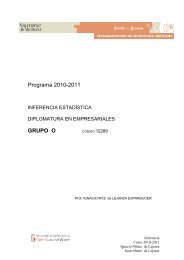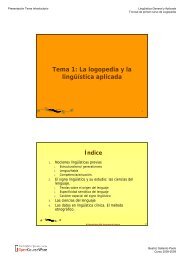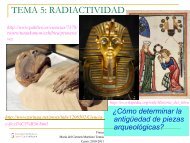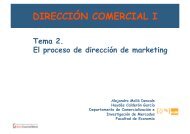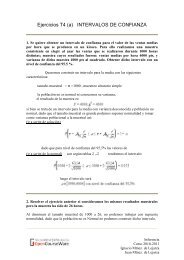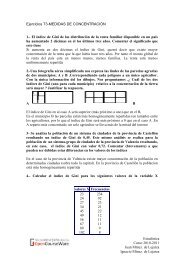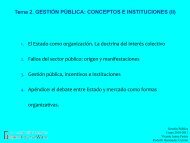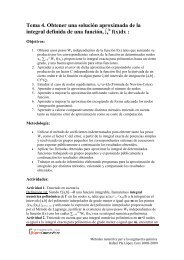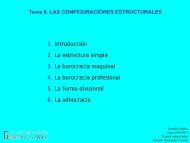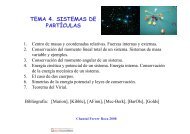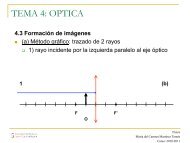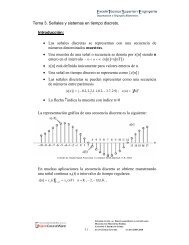Act of utterance and the utterance, act of utterance - OCW de la ...
Act of utterance and the utterance, act of utterance - OCW de la ...
Act of utterance and the utterance, act of utterance - OCW de la ...
- No tags were found...
Create successful ePaper yourself
Turn your PDF publications into a flip-book with our unique Google optimized e-Paper software.
05.02. Enunciative analysis <strong>of</strong> impaired speech samples: speech <strong>act</strong>s - 100char<strong>act</strong>erised by its "absence <strong>of</strong> conceptual value" 14 <strong>and</strong> by <strong>the</strong> completeabsorption <strong>of</strong> <strong>the</strong> <strong>utterance</strong> by <strong>the</strong> <strong>utterance</strong> <strong>act</strong>. In this sense, <strong>the</strong>interjection emerges as a "joker" morphosynt<strong>act</strong>ic category, able to adoptany propositional value assigned to it by contextual interpretation. Thisflexibility makes it <strong>the</strong> i<strong>de</strong>al temp<strong>la</strong>te, as any <strong>la</strong>nguage element can serve assupport for <strong>the</strong> interjection; this means it can also be char<strong>act</strong>erised(Vázquez 2003) 15 as a non-<strong>de</strong>scriptive lexical unit with a connecting function.- LOCUTIONARY ACTS [AL] 16 : <strong>the</strong>se are filling <strong>utterance</strong>s, very simi<strong>la</strong>r to filledpauses, with which <strong>the</strong> speaker materialises <strong>the</strong>ir turn without really sayinganything in grammatical terms. These speech <strong>act</strong>s can be un<strong>de</strong>rstood as aseparation <strong>of</strong> <strong>the</strong> locutionary <strong>and</strong> propositional dimensions <strong>of</strong> <strong>the</strong> speech<strong>act</strong>, so <strong>the</strong>re is a locution but no real semantic or informative content can beextr<strong>act</strong>ed from it. Discursive markers <strong>and</strong> pronouns with this function arefrequently used, toge<strong>the</strong>r with a leng<strong>the</strong>ned pronunciation (yooo…, éeel…,pueees…).• EDITING TASKS: this concept is adapted to Ca<strong>the</strong>rine Crockford <strong>and</strong> Ruth Lesser'ssuggestions in <strong>the</strong>ir Quantification <strong>of</strong> Conversational Behaviours protocol, althoughwith some slight variations. On o<strong>the</strong>r occasions we have <strong>de</strong>scribed <strong>the</strong>se behaviourscomparing <strong>the</strong>m to <strong>the</strong> tasks involved in film editing, in which <strong>the</strong> editor discardsfalse takes <strong>and</strong> puts toge<strong>the</strong>r <strong>the</strong> ones that make up <strong>the</strong> final version. There arevarious behaviours with this function:- FILLED PAUSES [PO]: we quantify <strong>the</strong> vocalisations with which <strong>the</strong> speakerfills silence so as not to lose <strong>the</strong>ir turn while <strong>the</strong>y p<strong>la</strong>n <strong>the</strong>ir intervention 17 ;our transcription conventions use <strong>the</strong> st<strong>and</strong>ard convention <strong>of</strong> marking<strong>the</strong>se paralinguistic prolongations with a maximum <strong>of</strong> three vowels (uuum,eeeh), so we do not take <strong>the</strong> real length <strong>of</strong> this vocalisation into account.Filled pauses were i<strong>de</strong>ntified in everyday speech by Mac<strong>la</strong>y <strong>and</strong> Osgood(1959) 18 , as a sign that <strong>the</strong> speaker does not want to give up <strong>the</strong> turn <strong>and</strong> issimply searching for <strong>the</strong> appropriate words; with <strong>the</strong>se <strong>utterance</strong>s <strong>the</strong>listener would un<strong>de</strong>rst<strong>and</strong> that <strong>the</strong> speaker has not yet finished <strong>and</strong> would<strong>the</strong>refore not interrupt <strong>the</strong>m. This is <strong>the</strong> value <strong>of</strong> <strong>the</strong> PROLONGATORSi<strong>de</strong>ntified by Jefferson <strong>and</strong> referred to by Coulthard as incompletion markers.But many interruptions in everyday conversation are ma<strong>de</strong> precisely bytaking advantage <strong>of</strong> <strong>the</strong> o<strong>the</strong>r person's filled pause, <strong>and</strong> some psychologistshave questioned Mac<strong>la</strong>y <strong>and</strong> Osgood's interpretations. Thus, M.Cook <strong>and</strong>M. Lalljee (1970) 19 did some experiments that appeared to contradict <strong>the</strong>hypo<strong>the</strong>sis that listeners interpret <strong>the</strong> filled pause as an unfinished turn.Years <strong>la</strong>ter, Ball (1975) 20 picked up <strong>the</strong> issue once again <strong>and</strong> <strong>de</strong>monstratedthat <strong>the</strong> experiments carried out by Cook <strong>and</strong> Lalljee 21 were not comparable14 López-García Ángel (1989): Fundamentos <strong>de</strong> lingüística perceptiva. Madrid: Gredos.15 Vázquez-Veiga, Nancy (2003): Marcadores discursivos <strong>de</strong> recepción, Santiago <strong>de</strong> Composte<strong>la</strong>: Universida<strong>de</strong>.16 We prefer <strong>the</strong> term "locutionary" to "enunciative" as it better reflects <strong>the</strong> "loquens" ability.17 Jaffe J., Feldstein S. (1970): Rhythms <strong>of</strong> Dialogue. New York, Aca<strong>de</strong>mic Press.18 Mac<strong>la</strong>y, Howard <strong>and</strong> Osgood, Charles E. (1959): "Hesitation phenomena in spontaneous Englishspeech", Word, 15, 19-44.19 COOK, Mark <strong>and</strong> LALLJEE, Mansur G. (1970): "The interpretation <strong>of</strong> pauses by <strong>the</strong> listener", BritishJournal <strong>of</strong> Social <strong>and</strong> Clinical Psychology, 9, pp.375-377.20 Ball, Peter (1975): "Listener responses to filled pauses in re<strong>la</strong>tion to floor apportionment", British Journal<strong>of</strong> Social <strong>and</strong> Clinical Psychology, 14, pp.423-425.21 In <strong>the</strong> first, subjects heard a speaker <strong>and</strong> <strong>the</strong>y were asked to indicate, by pressing a button, when <strong>the</strong>ythought <strong>the</strong> speaker had finished speaking. They were given eight short <strong>utterance</strong>s, <strong>of</strong> <strong>the</strong> type I have leftmy books in <strong>the</strong> library, with four versions <strong>of</strong> each one: complete, incomplete, complete with filled pause,Linguistic Analysis <strong>of</strong> Speech Language Disor<strong>de</strong>rsBeatriz Gal<strong>la</strong>rdo Paúls. Course 2008-2009.



